Age-Related Changes in Neuroinflammation and Epigenetic Regulation in Mouse Ischemic Stroke Model
Abstract
1. Introduction
2. Materials and Methods
2.1. Animals
2.2. Photothrombotic Ischemic Stroke Model
2.3. Histological Analyses
2.4. RNA Purification and RT-qPCR
2.5. Statistical Analyses
3. Results
3.1. Different Astrocyte Morphologies in the Penumbra Region Between Young and Old Mice
3.2. Noninfectious Inflammatory Reaction in the Early Phase with Different Characteristics in Young and Old Mice
3.3. Age-Dependent Variation in TLR—Cytokine Correlation After Ischemic Stroke
3.4. HDAC7 as an Age-Dependent Regulator Through Epigenetic Modification
4. Discussion
4.1. Differences in Glial Cells in the Infarct Region Between Young Mice and Old Ones
4.2. Noninfectious Neuroinflammation and Specific Inflammatory Cytokine Upregulation in Old Mice
4.3. In Old Mice, Cytokines with Upregulated Expression Exhibited an Altered Correlation with Their Master Regulator
4.4. Future Perspectives
5. Conclusions
Supplementary Materials
Author Contributions
Funding
Institutional Review Board Statement
Informed Consent Statement
Data Availability Statement
Acknowledgments
Conflicts of Interest
Abbreviations
| AIF1 | Allograft inflammatory factor 1 |
| ANOVA | Analysis of variance |
| AQP4 | Aquaporin-4 |
| BW | Body weight |
| GFAP | Glial fibrillary acidic protein |
| HDAC | Histone deacetylases |
| IBA1 | Ionized calcium-binding adaptor molecule 1 |
| MCAO | Middle cerebral artery occlusion |
| PBS | Phosphate-buffered saline |
| RT-qPCR | Quantitative reverse transcription polymerase chain reaction |
| TLR | Toll-like receptor |
References
- Simmons, C.A.; Poupore, N.; Nathaniel, T.I. Age stratification and stroke severity in the telestroke network. J. Clin. Med. 2023, 12, 1519. [Google Scholar] [CrossRef]
- Azarpazhooh, M.R.; Avan, A.; Cipriano, L.E.; Munoz, D.G.; Sposato, L.A.; Hachinski, V. Concomitant vascular and neurodegenerative pathologies double the risk of dementia. Alzheimers Dement. 2018, 14, 148–156. [Google Scholar] [CrossRef]
- Feigin, V.; Stark, B.A.; Johnson, C.O.; Roth, G.A.; Bisignano, C.; Gebreheat, G.; Abbasifard, M.; Abbasi-Kangevari, M.; Abd-Allah, F.; Abedi, V.; et al. Global, regional, and national burden of stroke and its risk factors, 1990–2019: A systematic analysis for the Global Burden of Disease Study 2019. Lancet Neurol. 2021, 20, 795–820. [Google Scholar] [CrossRef]
- Hilkens, N.A.; Casolla, B.; Leung, T.W.; de Leeuw, F.-E. Stroke. Lancet 2024, 403, 2820–2836. [Google Scholar] [CrossRef]
- Moskowitz, M.A.; Lo, E.H.; Iadecola, C. The science of stroke: Mechanisms in search of treatments. Neuron 2010, 67, 181–198. [Google Scholar] [CrossRef]
- Sacco, R.L.; Kasner, S.E.; Broderick, J.P.; Caplan, L.R.; Connors, J.J.B.; Culebras, A.; Elkind, M.S.V.; George, M.G.; Hamdan, A.D.; Higashida, R.T.; et al. An updated definition of stroke for the 21st century: A statement for healthcare professionals from the American Heart Association/American Stroke Association. Stroke 2013, 44, 2064–2089. [Google Scholar] [CrossRef]
- Maida, C.D.; Norrito, R.L.; Daidone, M.; Tuttolomondo, A.; Pinto, A. Neuroinflammatory mechanisms in ischemic stroke: Focus on cardioembolic stroke, background, and therapeutic approaches. Int. J. Mol. Sci. 2020, 21, 6454. [Google Scholar] [CrossRef]
- Kumari, S.; Dhapola, R.; Sharma, P.; Nagar, P.; Medhi, B.; HariKrishnaReddy, D. The impact of cytokines in neuroinflammation-mediated stroke. Cytokine Growth Factor Rev. 2024, 78, 105–119. [Google Scholar] [CrossRef] [PubMed]
- Iadecola, C.; Anrather, J. The immunology of stroke: From mechanisms to translation. Nat. Med. 2011, 17, 796–808. [Google Scholar] [CrossRef] [PubMed]
- Mo, Y.; Sun, Y.-Y.; Liu, K.-Y. Autophagy and inflammation in ischemic stroke. Neural Regen. Res. 2020, 15, 1388–1396. [Google Scholar] [CrossRef] [PubMed]
- Chen, R.L.; Balami, J.S.; Esiri, M.M.; Chen, L.-K.; Buchan, A.M. Ischemic stroke in the elderly: An overview of evidence. Nat. Rev. Neurol. 2010, 6, 256–265. [Google Scholar] [CrossRef]
- Shen, F.; Jiang, L.; Han, F.; Degos, V.; Chen, S.; Su, H. Increased inflammatory response in old mice is associated with more severe neuronal injury at the acute stage of ischemic stroke. Aging Dis. 2019, 10, 12–22. [Google Scholar] [CrossRef]
- Tuohy, M.C.; Hillman, E.M.C.; Marshall, R.; Agalliu, D. The age-dependent immune response to ischemic stroke. Curr. Opin. Neurobiol. 2023, 78, 102670. [Google Scholar] [CrossRef]
- Kondo, M.; Okazaki, H.; Nakayama, K.; Hohjoh, H.; Nakagawa, K.; Segi-Nishida, E.; Hasegawa, H. Characterization of astrocytes in the minocycline-administered mouse photothrombotic ischemic stroke model. Neurochem. Res. 2022, 47, 2839–2855. [Google Scholar] [CrossRef]
- Hasegawa, H.; Nakayama, K. Malnutrition-induced involution of lymph nodes in mice. BPB Rep. 2022, 5, 133–139. [Google Scholar] [CrossRef]
- Razali, N.; Horikawa, I.; Hohjoh, H.; Yoshikawa, C.; Hasegawa, H. Prostaglandin-modulated interaction of thymic progenitor cells with blood vessels during estradiol-induced thymic involution. BPB Rep. 2019, 2, 39–47. [Google Scholar] [CrossRef]
- Sharma, V.; Sharma, P.; Singh, T.G. Mechanistic insights on TLR-4 mediated inflammatory pathway in neurodegenerative diseases. Pharmacol. Rep. 2024, 76, 679–692. [Google Scholar] [CrossRef]
- Yawoot, N.; Tocharus, J.; Tocharus, C. Toll-like receptor 4-mediated neuroinflammation: Updates on pathological roles and therapeutic strategies in chronic cerebral hypoperfusion. Mol. Neurobiol. 2025, 62, 7242–7267. [Google Scholar] [CrossRef]
- Zhao, L.-X.; Du, J.-R.; Zhou, H.-J.; Liu, D.-L.; Gu, M.-X.; Long, F.-Y. Differences in proinflammatory property of six subtypes of peroxiredoxins and anti-inflammatory effect of ligustilide in macrophages. PLoS ONE 2016, 11, e0164586. [Google Scholar] [CrossRef] [PubMed]
- Lin, F.; Li, G.; Lu, J.; Han, H.; Zhang, R.; Zhu, H.; Zhao, W. Improving stroke prognosis by TLR4 KO to enhance N2 neutrophil infiltration and reduce M1 macrophage polarization. Cell Biochem. Funct. 2024, 42, e4059. [Google Scholar] [CrossRef] [PubMed]
- Mao, L.; Wu, D.-H.; Hu, G.-H.; Fan, J.-H. TLR4 enhances cerebral ischemia/reperfusion injury via regulating NLRP3 inflammasome and autophagy. Mediat. Inflamm. 2023, 2023, 9335166. [Google Scholar] [CrossRef] [PubMed]
- la Torre, A.; Vecchio, F.L.; Greco, A. Epigenetic mechanisms of aging and aging-associated diseases. Cells 2023, 12, 1163. [Google Scholar] [CrossRef]
- Zhang, W.; Qu, J.; Liu, G.-H.; Belmonte, J.C.I. The ageing epigenome and its rejuvenation. Nat. Rev. Mol. Cell Biol. 2020, 21, 137–150. [Google Scholar] [CrossRef]
- Seto, E.; Yoshida, M. Erasers of histone acetylation: The histone deacetylase enzymes. Cold Spring Harb. Perspect. Biol. 2014, 6, a018713. [Google Scholar] [CrossRef]
- Wang, Y.; Abrol, R.; Mak, J.Y.W.; Gupta, K.D.; Ramnath, D.; Karunakaran, D.; Fairlie, D.P.; Sweet, M.J. Histone deacetylase 7: A signalling hub controlling development, inflammation, metabolism and disease. FEBS J. 2023, 290, 2805–2832. [Google Scholar] [CrossRef]
- Shakespear, M.R.; Hohenhaus, D.M.; Kelly, G.M.; Kamal, N.A.; Gupta, P.; Labzin, L.I.; Schroder, K.; Garceau, V.; Barbero, S.; Iyer, A.; et al. Histone deacetylase 7 promotes Toll-like receptor 4-dependent proinflammatory gene expression in macrophages. J. Biol. Chem. 2013, 288, 25362–25374. [Google Scholar] [CrossRef]
- Ye, J.; Zhong, S.; Deng, Y.; Yao, X.; Liu, Q.; Wang, J.-Z.; Xiao, S. HDAC7 activates IKK/NF-κB signaling to regulate astrocyte-mediated inflammation. Mol. Neurobiol. 2022, 59, 6141–6157. [Google Scholar] [CrossRef]
- Catanese, L.; Tarsia, J.; Fisher, M. Acute ischemic stroke therapy overview. Circ. Res. 2017, 120, 541–558. [Google Scholar] [CrossRef]
- Cao, Y.; Yue, X.; Jia, M.; Wang, J. Neuroinflammation and anti-inflammatory therapy for ischemic stroke. Heliyon 2023, 9, e17986. [Google Scholar] [CrossRef] [PubMed]
- Rayasam, A.; Hsu, M.; Kijak, J.A.; Kissel, L.; Hernandez, G.; Sandor, M.; Fabry, Z. Immune responses in stroke: How the immune system contributes to damage and healing after stroke and how this knowledge could be translated to better cures? Immunology 2018, 154, 363–376. [Google Scholar] [CrossRef] [PubMed]
- Choudhury, R.; Ding, S. Reactive astrocytes and therapeutic potential in focal ischemic stroke. Neurobiol. Dis. 2016, 85, 234–244. [Google Scholar] [CrossRef] [PubMed]
- Lambertsen, K.L.; Finsen, B.; Clausen, B.H. Post-stroke inflammation-target or tool for therapy? Acta Neuropathol. 2019, 137, 693–714. [Google Scholar] [CrossRef]
- Williamson, M.R.; Fuertes, C.J.A.; Dunn, A.K.; Drew, M.R.; Jones, T.A. Reactive astrocytes facilitate vascular repair and remodeling after stroke. Cell Rep. 2021, 35, 109048. [Google Scholar] [CrossRef]
- Huang, L.; Wu, Z.-B.; Zhuge, Q.; Zheng, W.; Shao, B.; Wang, B.; Sun, F.; Jin, K. Glial scar formation occurs in the human brain after ischemic stroke. Int. J. Med. Sci. 2014, 11, 344–348. [Google Scholar] [CrossRef]
- Shen, X.-Y.; Gao, Z.-K.; Han, Y.; Yuan, M.; Guo, Y.-S.; Bi, X. Activation and role of astrocytes in ischemic stroke. Front. Cell. Neurosci. 2021, 15, 755955. [Google Scholar] [CrossRef] [PubMed]
- Meyer, L.; Schönfeld, M.; Bechstein, M.; Hanning, U.; Cheng, B.; Thomalla, G.; Schön, G.; Kemmling, A.; Fiehler, J.; Broocks, G. Ischemic lesion water homeostasis after thrombectomy for large vessel occlusion stroke within the anterior circulation: The impact of age. J. Cereb. Blood Flow Metab. 2021, 41, 45–52. [Google Scholar] [CrossRef]
- Timaru-Kast, R.; Luh, C.; Gotthardt, P.; Huang, C.; Schäfer, M.K.; Engelhard, K.; Thal, S.C. Influence of age on brain edema formation, secondary brain damage and inflammatory response after brain trauma in mice. PLoS ONE 2012, 7, e43829. [Google Scholar] [CrossRef]
- Zeppenfeld, D.M.; Simon, M.; Haswell, J.D.; D’Abreo, D.; Murchison, C.; Quinn, J.F.; Grafe, M.R.; Woltjer, R.L.; Kaye, J.; Iliff, J.J. Association of perivascular localization of aquaporin-4 with cognition and Alzheimer disease in aging brains. JAMA Neurol. 2017, 74, 91–99. [Google Scholar] [CrossRef]
- Owasil, R.; O’Neill, R.; Keable, A.; Nimmo, J.; Sharp, M.M.; Kelly, L.; Saito, S.; Simpson, J.E.; Weller, R.O.; Smith, C.; et al. The pattern of AQP4 expression in the ageing human brain and in cerebral amyloid angiopathy. Int. J. Mol. Sci. 2020, 21, 1225. [Google Scholar] [CrossRef]
- Garland, E.F.; Hartnell, I.J.; Boche, D. Microglia and astrocyte function and communication: What do we know in humans? Front. Neurosci. 2022, 16, 824888. [Google Scholar] [CrossRef] [PubMed]
- Matejuk, A.; Ransohoff, R.M. Crosstalk between astrocytes and microglia: An overview. Front. Immunol. 2020, 11, 1416. [Google Scholar] [CrossRef]
- Ana, B. Aged-Related Changes in Microglia and Neurodegenerative Diseases: Exploring the Connection. Biomedicines 2024, 12, 1737. [Google Scholar] [CrossRef]
- Fang, Y.; Wang, J.; Yao, L.; Li, C.; Wang, J.; Liu, Y.; Tao, X.; Sun, H.; Liao, H. The adhesion and migration of microglia to β-amyloid (Aβ) is decreased with aging and inhibited by Nogo/NgR pathway. J. Neuroinflamm. 2018, 15, 210. [Google Scholar] [CrossRef]
- Doll, D.N.; Barr, T.L.; Simpkins, J.W. Cytokines: Their role in stroke and potential use as biomarkers and therapeutic targets. Aging Dis. 2014, 5, 294–306. [Google Scholar] [CrossRef]
- Fassbender, K.; Rossol, S.; Kammer, T.; Daffertshofer, M.; Wirth, S.; Dollman, M.; Hennerici, M. Proinflammatory cytokines in serum of patients with acute cerebral ischemia: Kinetics of secretion and relation to the extent of brain damage and outcome of disease. J. Neurol. Sci. 1994, 122, 135–139. [Google Scholar] [CrossRef]
- Lambertsen, K.L.; Biber, K.; Finsen, B. Inflammatory cytokines in experimental and human stroke. J. Cereb. Blood Flow Metab. 2012, 32, 1677–1698. [Google Scholar] [CrossRef]
- Finger, C.E.; Moreno-Gonzalez, I.; Gutierrez, A.; Moruno-Manchon, J.F.; McCullough, L.D. Age-related immune alterations and cerebrovascular inflammation. Mol. Psychiatry 2022, 27, 803–818. [Google Scholar] [CrossRef] [PubMed]
- Porcher, L.; Bruckmeier, S.; Burbano, S.D.; Finnell, J.E.; Gorny, N.; Klett, J.; Wood, S.K.; Kelly, M.P. Aging triggers an upregulation of a multitude of cytokines in the male and especially the female rodent hippocampus but more discrete changes in other brain regions. J. Neuroinflamm. 2021, 18, 219. [Google Scholar] [CrossRef] [PubMed]
- Rea, I.M.; Gibson, D.S.; McGilligan, V.; McNerlan, S.E.; Alexander, H.D.; Ross, O.A. Age and age-related diseases: Role of inflammation triggers and cytokines. Front. Immunol. 2018, 9, 586. [Google Scholar] [CrossRef] [PubMed]
- Amin, M.; Vakilian, A.; Mahmoodi, M.H.; Hassanshahi, G.; Falahati-Pour, S.K.; Dolatabadi, M.R.; Nadimi, A.E. Circulatory levels of C-X-C motif chemokine ligands 1, 9, and 10 are elevated in patients with ischemic stroke. Eurasian J. Med. 2017, 49, 92–96. [Google Scholar] [CrossRef]
- Bonifačić, D.; Toplak, A.; Benjak, I.; Tokmadžić, V.S.; Lekić, A.; Kučić, N. Monocytes and monocyte chemoattractant protein 1 (MCP-1) as early predictors of disease outcome in patients with cerebral ischemic stroke. Wien Klin. Wochenschr. 2016, 128, 20–27. [Google Scholar] [CrossRef] [PubMed]
- Groom, J.R.; Luster, A.D. CXCR3 ligands: Redundant, collaborative and antagonistic functions. Immunol. Cell Biol. 2011, 89, 207–215. [Google Scholar] [CrossRef]
- Luster, A.D.; Ravetch, J.V. Biochemical characterization of a gamma interferon-inducible cytokine (IP-10). J. Exp. Med. 1987, 166, 1084–1097. [Google Scholar] [CrossRef] [PubMed]
- Neville, L.F.; Mathiak, G.; Bagasra, O. The immunobiology of interferon-gamma inducible protein 10 kD (IP-10): A novel, pleiotropic member of the C-X-C chemokine superfamily. Cytokine Growth Factor Rev. 1997, 8, 207–219. [Google Scholar] [CrossRef]
- Huen, A.C.; Wells, A. The beginning of the end: CXCR3 signaling in late-stage wound healing. Adv. Wound Care 2012, 1, 244–248. [Google Scholar] [CrossRef]
- Lu, X.-L.; Jiang, X.-B.; Liu, R.-E.; Zhang, S.-M. The enhanced anti-angiogenic and antitumor effects of combining flk1-based DNA vaccine and IP-10. Vaccine 2008, 26, 5352–5357. [Google Scholar] [CrossRef]
- Sahin, H.; Borkham-Kamphorst, E.; Berres, M.-L.; Kaldenbach, M.; Schmitz, P.; Weiskirchen, R.; Liedtke, C.; Streetz, K.L.; Maedler, K.; Trautwein, C.; et al. Proapoptotic effects of the chemokine, CXCL10 are mediated by the noncognate receptor TLR4 in hepatocytes. Hepatology 2013, 57, 797–805. [Google Scholar] [CrossRef]
- Wang, Y.; Du, J.; Hu, Y.; Zhang, S. CXCL10 impairs synaptic plasticity and was modulated by cGAS-STING pathway after stroke in mice. J. Neurophysiol. 2024, 132, 722–732. [Google Scholar] [CrossRef]
- Babcock, A.A.; Kuziel, W.A.; Rivest, S.; Owens, T. Chemokine expression by glial cells directs leukocytes to sites of axonal injury in the CNS. J. Neurosci. 2003, 23, 7922–7930. [Google Scholar] [CrossRef]
- Si, Y.; Tsou, C.-L.; Croft, K.; Charo, I.F. CCR2 mediates hematopoietic stem and progenitor cell trafficking to sites of inflammation in mice. J. Clin. Investig. 2010, 120, 1192–1203. [Google Scholar] [CrossRef] [PubMed]
- Kurihara, T.; Warr, G.; Loy, J.; Bravo, R. Defects in macrophage recruitment and host defense in mice lacking the CCR2 chemokine receptor. J. Exp. Med. 1997, 186, 1757–1762. [Google Scholar] [CrossRef]
- Kuziel, W.A.; Morgan, S.J.; Dawson, T.C.; Griffin, S.; Smithies, O.; Ley, K.; Maeda, N. Severe reduction in leukocyte adhesion and monocyte extravasation in mice deficient in CC chemokine receptor 2. Proc. Natl. Acad. Sci. USA 1997, 94, 12053–12058. [Google Scholar] [CrossRef] [PubMed]
- Stamatovic, S.M.; Keep, R.F.; Kunkel, S.L.; Andjelkovic, A.V. Potential role of MCP-1 in endothelial cell tight junction ‘opening’: Signaling via Rho and Rho kinase. J. Cell Sci. 2003, 116, 4615–4628. [Google Scholar] [CrossRef]
- Strecker, J.-K.; Minnerup, J.; Schütte-Nütgen, K.; Gess, B.; Schäbitz, W.-R.; Schilling, M. Monocyte chemoattractant protein-1-deficiency results in altered blood-brain barrier breakdown after experimental stroke. Stroke 2013, 44, 2536–2544. [Google Scholar] [CrossRef] [PubMed]
- Yao, Y.; Tsirka, S.E. Monocyte chemoattractant protein-1 and the blood-brain barrier. Cell. Mol. Life Sci. 2014, 71, 683–697. [Google Scholar] [CrossRef]
- Geng, H.; Chen, L.; Tang, J.; Chen, Y.; Wang, L. The role of CCL2/CCR2 axis in cerebral ischemia-reperfusion injury and treatment: From animal experiments to clinical trials. Int. J. Mol. Sci. 2022, 23, 3485. [Google Scholar] [CrossRef]
- Zhang, Y.; Gao, Z.; Wang, D.; Zhang, T.; Sun, B.; Mu, L.; Wang, J.; Liu, Y.; Kong, Q.; Liu, X.; et al. Accumulation of natural killer cells in ischemic brain tissues and the chemotactic effect of IP-10. J. Neuroinflamm. 2014, 11, 79. [Google Scholar] [CrossRef]
- Anttila, J.E.; Whitaker, K.W.; Wires, E.S.; Harvey, B.K.; Airavaara, M. Role of microglia in ischemic focal stroke and recovery: Focus on Toll-like receptors. Prog. Neuropsychopharmacol. Biol. Psychiatry 2017, 79, 3–14. [Google Scholar] [CrossRef]
- Korostynski, M.; Hoinkis, D.; Piechota, M.; Golda, S.; Pera, J.; Slowik, A.; Dziedzic, T. Toll-like receptor 4-mediated cytokine synthesis and post-stroke depressive symptoms. Transl. Psychiatry 2021, 11, 246. [Google Scholar] [CrossRef]
- Davis, F.M.; denDekker, A.; Kimball, A.; Joshi, A.D.; Azzouny, M.E.; Wolf, S.J.; Obi, A.T.; Lipinski, J.; Gudjonsson, J.E.; Xing, X.; et al. Epigenetic regulation of TLR4 in diabetic macrophages modulates immunometabolism and wound repair. J. Immunol. 2020, 204, 2503–2513. [Google Scholar] [CrossRef] [PubMed]
- Takahashi, K.; Sugi, Y.; Hosono, A.; Kaminogawa, S. Epigenetic regulation of TLR4 gene expression in intestinal epithelial cells for the maintenance of intestinal homeostasis. J. Immunol. 2009, 183, 6522–6529. [Google Scholar] [CrossRef]
- Wang, K.; Liu, H.; Hu, Q.; Wang, L.; Liu, J.; Zheng, Z.; Zhang, W.; Ren, J.; Zhu, F.; Liu, G.-H. Epigenetic regulation of aging: Implications for interventions of aging and diseases. Signal Transduct. Target. Ther. 2022, 7, 374. [Google Scholar] [CrossRef]
- Ho, T.C.S.; Chan, A.H.Y.; Ganesan, A. Thirty years of HDAC inhibitors: 2020 insight and hindsight. J. Med. Chem. 2020, 63, 12460–12484. [Google Scholar] [CrossRef]
- Lahm, A.; Paolini, C.; Pallaoro, M.; Nardi, M.C.; Jones, P.; Neddermann, P.; Sambucini, S.; Bottomley, M.J.; Surdo, P.L.; Carfí, A.; et al. Unraveling the hidden catalytic activity of vertebrate class IIa histone deacetylases. Proc. Natl. Acad. Sci. USA 2007, 104, 17335–17340. [Google Scholar] [CrossRef] [PubMed]
- Campisi, J.; Kapahi, P.; Lithgow, G.J.; Melov, S.; Newman, J.C.; Verdin, E. From discoveries in ageing research to therapeutics for healthy ageing. Nature 2019, 571, 183–192. [Google Scholar] [CrossRef] [PubMed]
- Howard, G.; Howard, V.J. Twenty years of progress toward understanding the stroke belt. Stroke 2020, 51, 742–750. [Google Scholar] [CrossRef]
- Palmer, A.K.; Jensen, M.D. Metabolic changes in aging humans: Current evidence and therapeutic strategies. J. Clin. Investig. 2022, 132, e158451. [Google Scholar] [CrossRef]
- Hohjoh, H.; Horikawa, I.; Nakagawa, K.; Segi-Nishida, E.; Hasegawa, H. Induced mRNA expression of matrix metalloproteinases Mmp-3, Mmp-12, and Mmp-13 in the infarct cerebral cortex of photothrombosis model mice. Neurosci. Lett. 2020, 739, 135406. [Google Scholar] [CrossRef] [PubMed]
- Razali, N.; Hohjoh, H.; Inazumi, T.; Maharjan, B.D.; Nakagawa, K.; Konishi, M.; Sugimoto, Y.; Hasegawa, H. Induced prostanoid synthesis regulates the balance between Th1- and Th2-producing inflammatory cytokines in the thymus of diet-restricted mice. Biol. Pharm. Bull. 2020, 43, 649–662. [Google Scholar] [CrossRef]

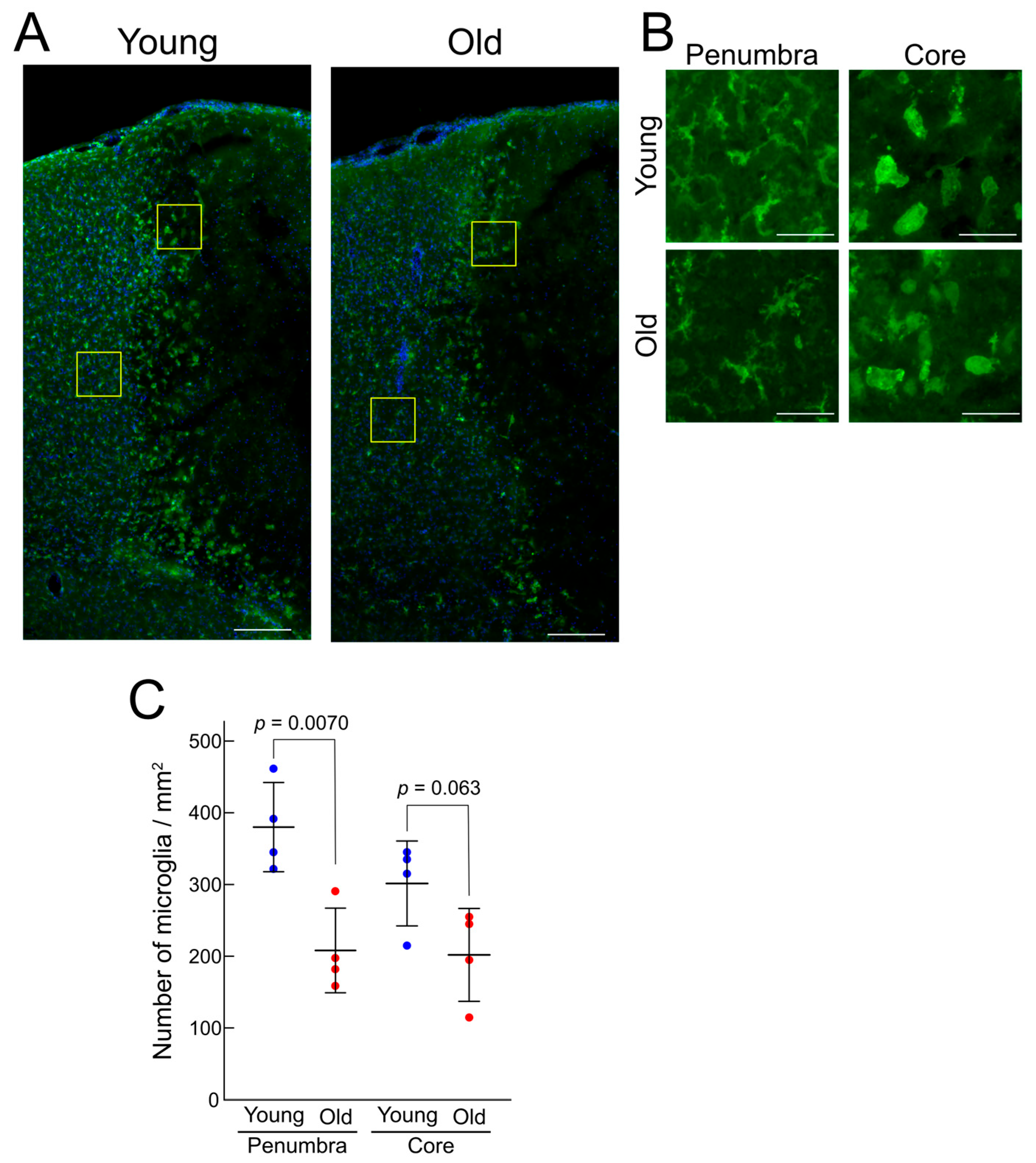
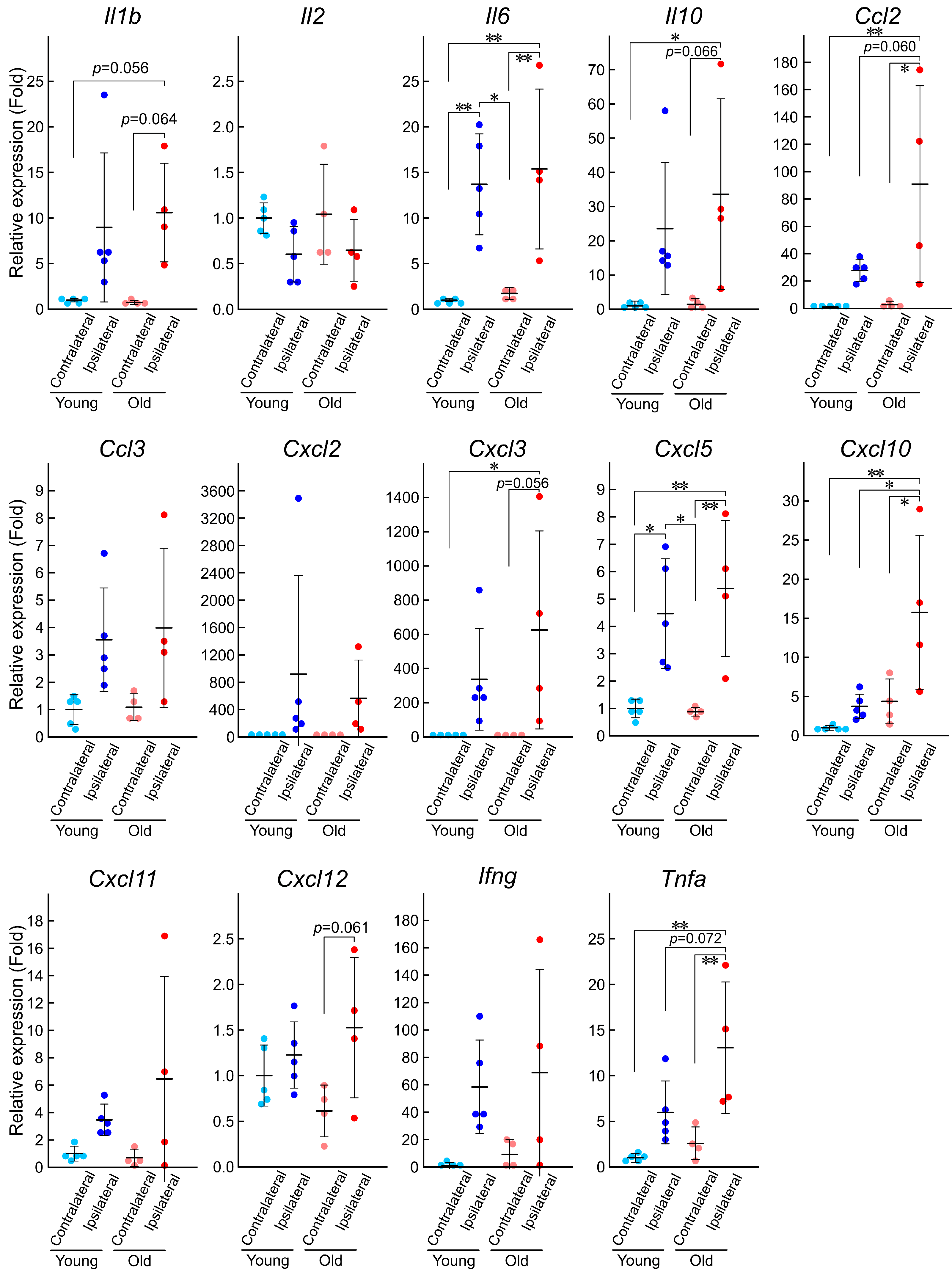
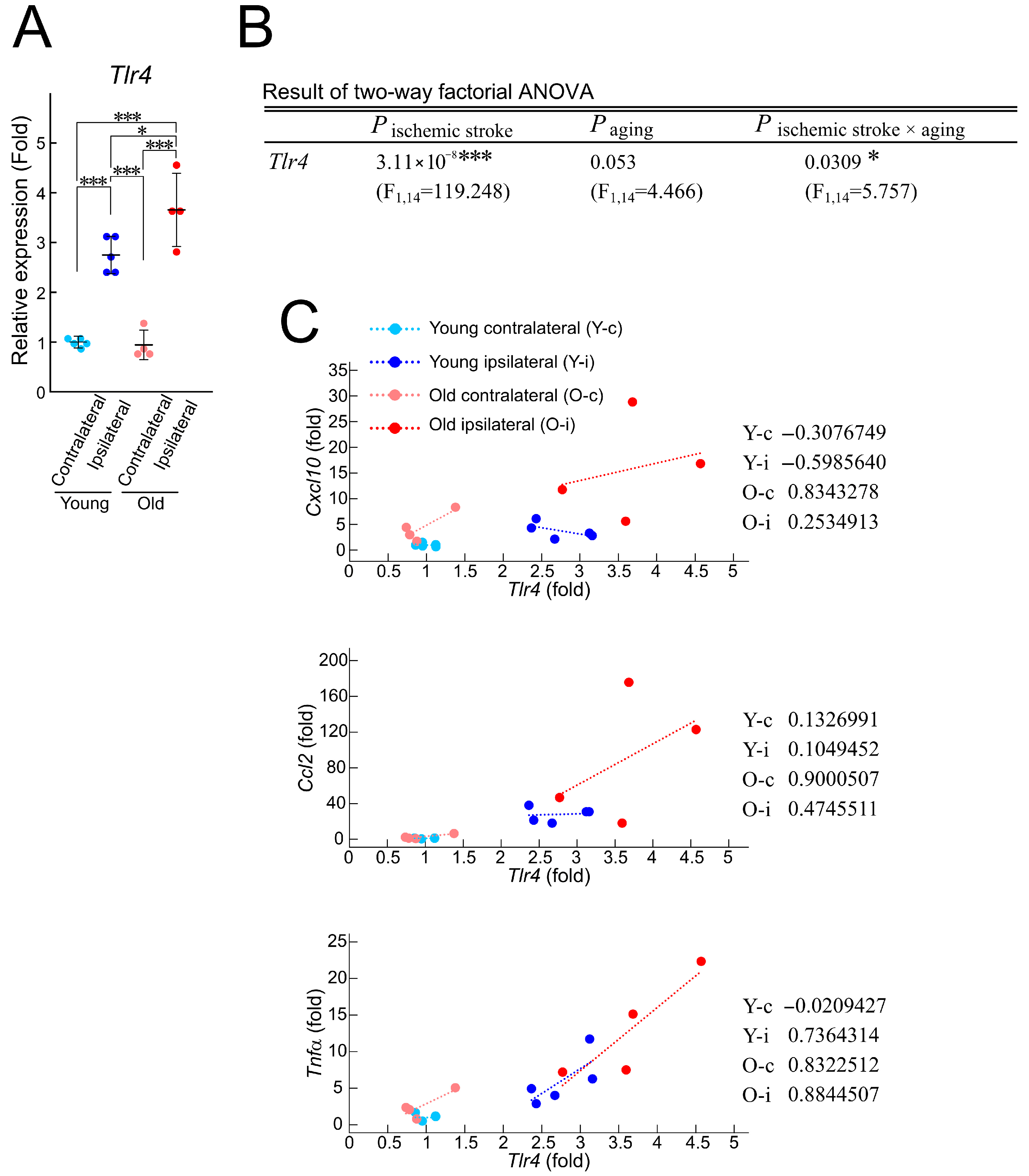
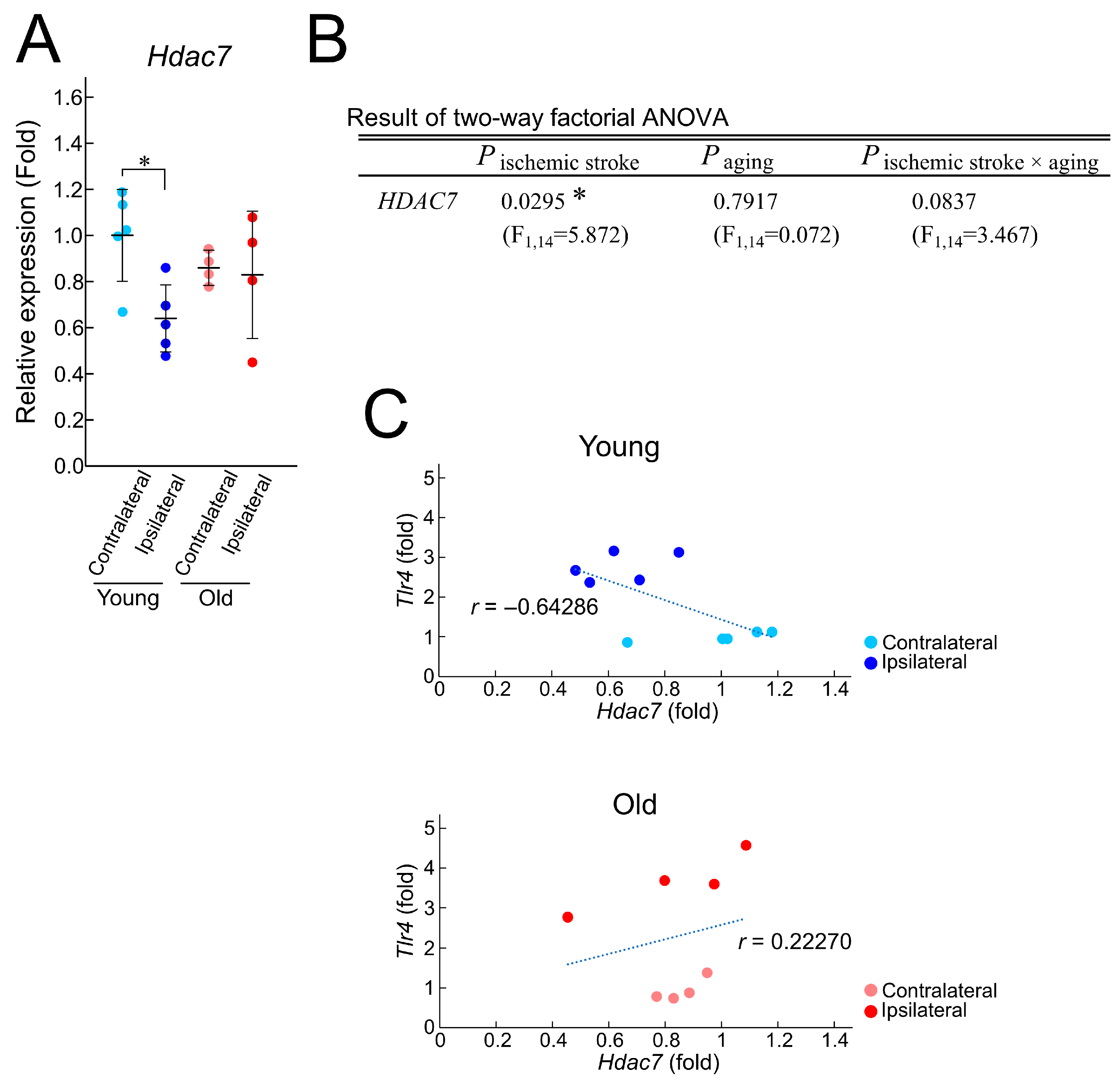
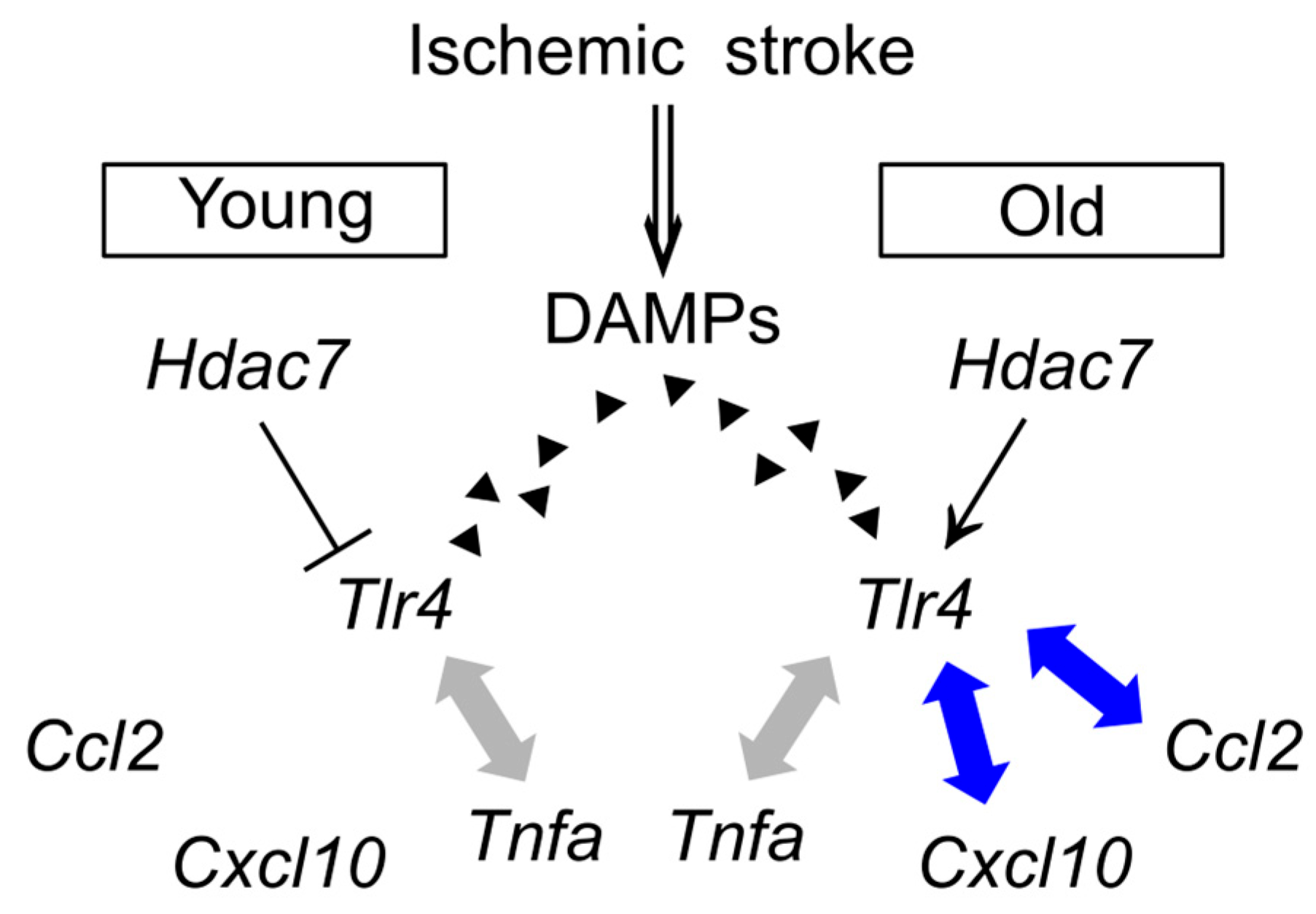
| mRNA | Pischemic stroke | Paging | Pischemic stroke×aging |
|---|---|---|---|
| Il1b | 0.00234 ** | 0.77720 | 0.69833 |
| (F1,14 = 13.748) | (F1,14 = 0.083) | (F1,14 = 0.157) | |
| Il2 | 0.0315 * | 0.7981 | 0.9987 |
| (F1,14 = 5.710) | (F1,14 = 0.068) | (F1,14 = 0.000) | |
| Il6 | 7.32 × 10-5 *** | 0.620 | 0.846 |
| (F1,14 = 30.662) | (F1,14 = 0.257) | (F1,14 = 0.039) | |
| Il10 | 0.00398 ** | 0.51329 | 0.54898 |
| (F1,14 = 11.835) | (F1,14 = 0.450) | (F1,14 = 0.377) | |
| Cxcl2 | 0.0676 | 0.6560 | 0.6492 |
| (F1,14 = 3.924) | (F1,14 = 0.207) | (F1,14 = 0.216) | |
| Cxcl3 | 0.00689 ** | 0.34562 | 0.34308 |
| (F1,14 = 10.012) | (F1,14 = 0.953) | (F1,14 = 0.963) | |
| Cxcl5 | 0.000121 *** | 0.605907 | 0.499443 |
| (F1,14 = 27.643) | (F1,14 = 0.279) | (F1,14 = 0.481) | |
| Cxcl10 | 0.01170 * | 0.00464 ** | 0.07939 |
| (F1,14 = 8.396) | (F1,14 = 11.314) | (F1,14 = 3.579) | |
| Cxcl11 | 0.034 * | 0.438 | 0.345 |
| (F1,14 = 5.523) | (F1,14 = 0.638) | (F1,14 = 0.956) | |
| Cxcl12 | 0.0287 * | 0.8440 | 0.1391 |
| (F1,14 = 5.946) | (F1,14 = 0.040) | (F1,14 = 2.459) | |
| Ccl2 | 0.00415 ** | 0.06155 | 0.07462 |
| (F1,14 = 11.693) | (F1,14 = 4.130) | (F1,14 = 3.711) | |
| Ccl3 | 0.00502 ** | 0.75379 | 0.83629 |
| (F1,14 = 11.045) | (F1,14 = 0.102) | (F1,14 = 0.044) | |
| Ifng | 0.00765 ** | 0.62959 | 0.95696 |
| (F1,14 = 9.683) | (F1,14 = 0.243) | (F1,14 = 0.003) | |
| Tnfa | 0.00126 ** | 0.03496 * | 0.16053 |
| (F1,14 = 16.169) | (F1,14 = 5.451) | (F1,14 = 2.196) |
Disclaimer/Publisher’s Note: The statements, opinions and data contained in all publications are solely those of the individual author(s) and contributor(s) and not of MDPI and/or the editor(s). MDPI and/or the editor(s) disclaim responsibility for any injury to people or property resulting from any ideas, methods, instructions or products referred to in the content. |
© 2025 by the authors. Licensee MDPI, Basel, Switzerland. This article is an open access article distributed under the terms and conditions of the Creative Commons Attribution (CC BY) license (https://creativecommons.org/licenses/by/4.0/).
Share and Cite
Kondo, M.; Tamura, H.; Segi-Nishida, E.; Hasegawa, H. Age-Related Changes in Neuroinflammation and Epigenetic Regulation in Mouse Ischemic Stroke Model. Brain Sci. 2025, 15, 810. https://doi.org/10.3390/brainsci15080810
Kondo M, Tamura H, Segi-Nishida E, Hasegawa H. Age-Related Changes in Neuroinflammation and Epigenetic Regulation in Mouse Ischemic Stroke Model. Brain Sciences. 2025; 15(8):810. https://doi.org/10.3390/brainsci15080810
Chicago/Turabian StyleKondo, Mari, Hayato Tamura, Eri Segi-Nishida, and Hiroshi Hasegawa. 2025. "Age-Related Changes in Neuroinflammation and Epigenetic Regulation in Mouse Ischemic Stroke Model" Brain Sciences 15, no. 8: 810. https://doi.org/10.3390/brainsci15080810
APA StyleKondo, M., Tamura, H., Segi-Nishida, E., & Hasegawa, H. (2025). Age-Related Changes in Neuroinflammation and Epigenetic Regulation in Mouse Ischemic Stroke Model. Brain Sciences, 15(8), 810. https://doi.org/10.3390/brainsci15080810







